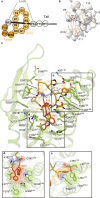Structure of a lasso peptide bound ETB receptor provides insights into the mechanism of GPCR inverse agonism
- PMID: 40263271
- PMCID: PMC12015262
- DOI: 10.1038/s41467-025-57960-x
Structure of a lasso peptide bound ETB receptor provides insights into the mechanism of GPCR inverse agonism
Abstract
Lasso peptides exhibit a unique lariat-like knotted structure imparting exceptional stability and thus show promise as therapeutic agents that target cell-surface receptors. One such receptor is the human endothelin type B receptor (ETB), which is implicated in challenging cancers with poor immunotherapy responsiveness. The Streptomyces-derived lasso peptide, RES-701-3, is a selective inhibitor for ETB and a compelling candidate for therapeutic development. However, meager production from a genetically recalcitrant host has limited further structure-activity relationship studies of this potent inhibitor. Here, we report cryo-electron microscopy structures of ETB receptor in both its apo form and complex with RES-701-3, facilitated by a calcineurin-fusion strategy. Hydrophobic interactions between RES-701-3 and the transmembrane region of the receptor, especially involving two tryptophan residues, play a crucial role in RES-701-3 binding. Furthermore, RES-701-3 prevents conformational changes associated with G-protein coupling, explaining its inverse agonist activity. A comparative analysis with other lasso peptides and their target proteins highlights the potential of lasso peptides as precise drug candidates for G-protein-coupled receptors. This structural insight into RES-701-3 binding to ETB receptor offers valuable information for the development of novel therapeutics targeting this receptor and provides a broader understanding of lasso peptide interactions with human cell-surface receptors.
© 2025. The Author(s).
Conflict of interest statement
Competing interests: O.N. is a co-founder and scientific advisor for Curreio. P.A.J., A.L., B.K.O., G.C.M.C., H.M., and M.J.B. are employed by Lassogen Inc. All other authors declare no competing interests.
Figures






References
-
- Maksimov, M. O., Pan, S. J. & James Link, A. Lasso peptides: structure, function, biosynthesis, and engineering. Nat. Prod. Rep.29, 996–1006 (2012). - PubMed
-
- Hegemann, J. D., Zimmermann, M., Xie, X. & Marahiel, M. A. Lasso peptides: an intriguing class of bacterial natural products. Acc. Chem. Res.48, 1909–1919 (2015). - PubMed
MeSH terms
Substances
Grants and funding
LinkOut - more resources
Full Text Sources

